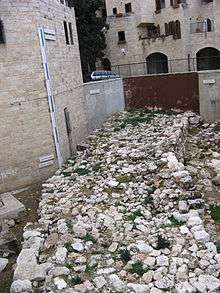Broad Wall (Jerusalem)

The Broad Wall is an ancient defensive wall in the Old City of Jerusalem. The wall was unearthed in the 1970s by Israeli architect Nahman Avigad and dated to the reign of King Hezekiah (late eighth century BCE).

The Broad Wall is a massive defensive structure, seven meters thick. The unbroken length of wall uncovered by Avigad's dig runs 65 metres (71.1 yd) long and is preserved in places to a height of 3.3 metres (3.6 yd).[1][2]
It was long believed that the city in this period was confined to the fortified, narrow hill running to the south of the Temple Mount known as the City of David. Avigad's dig demonstrated that by the late eighth century the city had expanded to include the hill to the west of the Temple Mount. The motivation for building the walls was the expected invasion of Judea by Sennacherib. The wall is referred to in Nehemiah 3:8 and Isaiah 22:9–10.
See also
References
| Wikimedia Commons has media related to The Broad Wall. |
- ↑ Jerusalem: an archaeological biography, Hershel Shanks,Random House, 1995, p. 80.
- ↑ Jewish Quarter Excavations in the Old City of Jerusalem: The finds from areas A, W and X-2 : final report. Volume 2 of Jewish Quarter Excavations in the Old City of Jerusalem: Conducted by Nahman Avigad, 1969–1982, Nahman Avigad, Hillel Geva, Israel Exploration Society, 2000.